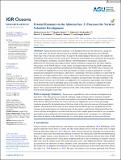| dc.contributor.author | Garcia‐Jove, Maximo | |
| dc.contributor.author | Mourre, Baptiste | |
| dc.contributor.author | Zarokanellos, Nikolaos D. | |
| dc.contributor.author | Lermusiaux, Pierre F. J. | |
| dc.contributor.author | Rudnick, Daniel L. | |
| dc.contributor.author | Tintoré, Joaquín | |
| dc.date.accessioned | 2024-03-19T13:45:18Z | |
| dc.date.available | 2024-03-19T13:45:18Z | |
| dc.date.issued | 2022-03 | |
| dc.identifier.issn | 2169-9275 | |
| dc.identifier.issn | 2169-9291 | |
| dc.identifier.uri | https://hdl.handle.net/1721.1/153819 | |
| dc.description.abstract | Significant lateral density gradients occur throughout the year in the Alboran Sea, giving rise to two main fronts: the Western Alboran Gyre Front (WAGF) and Eastern Alboran Gyre Front (EAGF), where large vertical velocities often develop. To improve the understanding of the processes that underlie the development of the vertical velocities in the fronts, the periods of development were analyzed in the perspective of the frontogenesis, instabilities, non‐linear Ekman, and filamentogenesis mechanisms, using multi‐platform in‐situ observations and a high‐resolution realistic simulation in spring 2018. The spatio‐temporal characteristics of the WAGF indicate a wider, deeper, and longer‐lasting front than the EAGF. Additionally, the WAGF shows stronger and deeper upwelling and downwelling regions. The WAGF vertical velocities (up to |55| m/day) are amplified by an across‐front ageostrophic secondary circulation generated by: (a) frontal intensification explained by frontogenesis, which shows a sharpening of buoyancy gradients associated with the Atlantic Jet, (b) nonlinear Ekman effects, that are enhanced by the persistent western wind blowing along the frontal direction, and (c) submesoscale instabilities (symmetric and ageostrophic baroclinic instabilities). The EAGF vertical velocities (up to |38| m/day) are amplified by two asymmetrical ageostrophic cells developed across the front with a narrow upwelling region in the middle. The cell's circulation is explained by frontal intensification produced by filamentogenesis through a cold filament advection to the Mediterranean Sea interior, that is characterized by pointy isopycnals at the center of the filament. This mechanism is observed in both the model and glider observations. | en_US |
| dc.language.iso | en | |
| dc.publisher | American Geophysical Union | en_US |
| dc.relation.isversionof | 10.1029/2021jc017428 | en_US |
| dc.rights | Creative Commons Attribution-NonCommercial-NoDerivs License | en_US |
| dc.rights.uri | https://creativecommons.org/licenses/by-nc-nd/4.0/ | en_US |
| dc.source | American Geophysical Union | en_US |
| dc.subject | Earth and Planetary Sciences (miscellaneous) | en_US |
| dc.subject | Space and Planetary Science | en_US |
| dc.subject | Geochemistry and Petrology | en_US |
| dc.subject | Geophysics | en_US |
| dc.subject | Oceanography | en_US |
| dc.title | Frontal Dynamics in the Alboran Sea: 2. Processes for Vertical Velocities Development | en_US |
| dc.type | Article | en_US |
| dc.identifier.citation | Garcia-Jove, M., Mourre, B., Zarokanellos, N. D., Lermusiaux, P. F. J., Rudnick, D. L., & Tintoré, J. (2022). Frontal dynamics in the Alboran Sea: 2. Processes for vertical velocities development. Journal of Geophysical Research: Oceans, 127, e2021JC017428. | en_US |
| dc.contributor.department | Massachusetts Institute of Technology. Department of Mechanical Engineering | |
| dc.relation.journal | Journal of Geophysical Research: Oceans | en_US |
| dc.eprint.version | Final published version | en_US |
| dc.type.uri | http://purl.org/eprint/type/JournalArticle | en_US |
| eprint.status | http://purl.org/eprint/status/PeerReviewed | en_US |
| dc.date.updated | 2024-03-19T13:36:30Z | |
| dspace.orderedauthors | Garcia‐Jove, M; Mourre, B; Zarokanellos, ND; Lermusiaux, PFJ; Rudnick, DL; Tintoré, J | en_US |
| dspace.date.submission | 2024-03-19T13:36:41Z | |
| mit.journal.volume | 127 | en_US |
| mit.journal.issue | 3 | en_US |
| mit.license | PUBLISHER_CC | |
| mit.metadata.status | Authority Work and Publication Information Needed | en_US |
